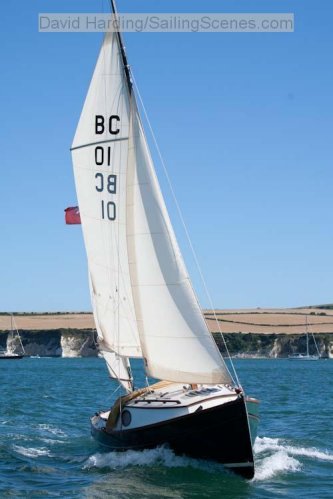On the whole I am very pleased with my 6HP Tohatsu outboard. But I don't like the gear lever. It is a little plastic projection right down on the starboard side at the bottom of the engine head. Changing gear always involved almost getting down on my knees to find it. Not a good idea in a difficult situation where you just want a short burst of reverse to save the day. Last year I fitted an extension to it made from a tiller extension arm I had made earlier. It proved the concept, but was terribly wobbly and imprecise. I have rebuilt it completely. Same tiller extension, but shortened and bolted more firmly to the lever. In addition I fitted plywood side cheeks, which surround the plastic gear lever. Finally I filled the hollow plastic lever itself with thickened epoxy resin, as it was a bit flexible. Finished the whole thing off with two primer coats, two under coats and two coats of gloss black enamel I had lying around for some reason. It looks almost like it is meant to be there, and works very well. I just hope it stands up to real world use.
I gather the current Tohatsu outboards have the gear lever on front, which is a much better idea, but my engine is quite new, so I wasn't planning an upgrade.
22 November 2013
11 November 2013
Cockpit floor supports
Last season I experimented with propping the cockpit floor boards up on the edges of the flat fenders, to give me a raised, high level platform to use at anchor. It was very successful and I had the floor up like that most evenings when I was on board. Also nice for lounging in the sun. But getting them up and the fenders into position was quite a hassle and I probably came nearer to falling overboard raising and lowering the floor than doing anything else.
10 November 2013
Boarding ladder extension
8 November 2013
Modifications to outboard well blanking plate
The blanking plate I fitted last year, in replacement of the plastic flaps, over the outboard well worked well, but was quite awkward to fit. There is not much room under the outboard itself when tilted up, and the projecting cross bars I fitted to the plate to stop it going right through the hole really got in the way. They catch on everything and I had to develop a very proscribed sequence of movements to get it in and out. Not an easy thing in a seaway.
So I have removed the bars and used two strips of thin ply across the underside of the well itself. These form ledges at the front and back of the well that the plate fits against. There will be slight increase in turbulence due to these plates, but they are very thin, so I think it will be negligible. The strips actually come from the plywood covers which originally held the plastic flaps in place. They already have CopperCoat on them. It is much easier to fit the plate now, although I can't test it in anger until next season. I am not planning to go back to the flaps.
7 November 2013
Cooker box complete
I have finished the cooker box and I am really quite pleased with the outcome. It holds all the bits I want it to hold and it is easy to move them all around the boat. This first picture shows it undergoing a well advised "CaptainParish" scorch test. I have filled the pan with water and heated it to boiling. The handles get warm, but that is all. I can actually pick it up with the flame at full blast, although I wouldn't recommend doing that. So I don't think there is a high scorch risk, but I will keep an eye on that.
The second picture shows it in place over the basin. I have painted it rather than varnished, because firstly I am useless at varnishing, and secondly it is made up of disparate bits of scrap wood, so they look better painted rather than bright
The third picture shows it outside on a cockpit bench, which is where I would place it when cooking. Apart from the risk of CO fumes, the burning meths stinks to high heaven.
The second picture shows it in place over the basin. I have painted it rather than varnished, because firstly I am useless at varnishing, and secondly it is made up of disparate bits of scrap wood, so they look better painted rather than bright
The third picture shows it outside on a cockpit bench, which is where I would place it when cooking. Apart from the risk of CO fumes, the burning meths stinks to high heaven.
6 November 2013
Head protection
Not a dramatic piece of work, but one I am glad I have completed. When I bolted on the new winch and halyard stoppers on the cabin roof, I had eight bolts protruding from the ceiling below, in a position where I could easily rip my head open. I have hacksawed back the long ends of the bolts (not that easy as I had to crouch whilst doing it) and then fitted a plywood cover over the remaining nuts. This is just an 18mm piece of marine ply, which I hollowed the back of using a plunge router. The ends of the ply are rounded off, so now I might still bump my head, but my brain, such as it is, might be left intact a bit longer.
1 November 2013
Cooker box under way
Subscribe to:
Posts (Atom)











